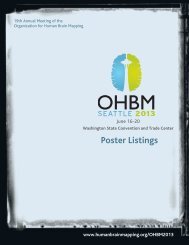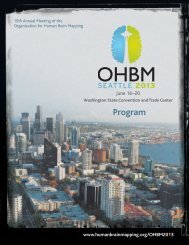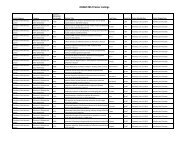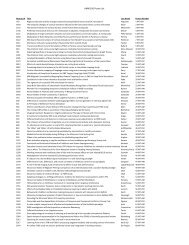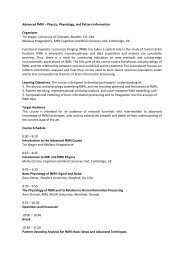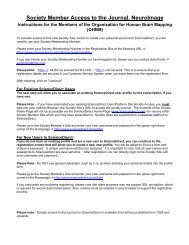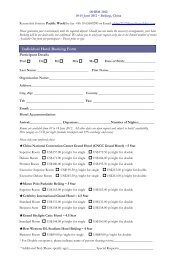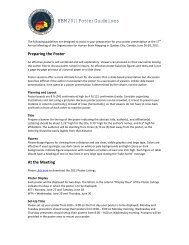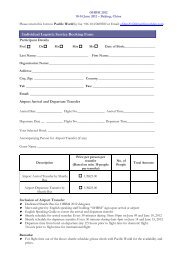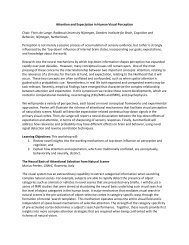HBM2010 - Organization for Human Brain Mapping
HBM2010 - Organization for Human Brain Mapping
HBM2010 - Organization for Human Brain Mapping
Create successful ePaper yourself
Turn your PDF publications into a flip-book with our unique Google optimized e-Paper software.
EDUCATIONAL COURSES<br />
Dynamic Models in Systems<br />
Neuroscience<br />
Sala H1 (Level -1)<br />
ORGANIZERS<br />
Michael Breakspear, Queensland Institute of Medical<br />
Research, Brisbane, Australia<br />
Stefan Kiebel, Max Planck Institute <strong>for</strong> <strong>Human</strong> Cognitive<br />
and <strong>Brain</strong> Sciences, Leipzig, Germany<br />
This course is designed to guide both cognitive<br />
neuroscientists and modellers through a variety of<br />
computational approaches. The talks introduce and motivate<br />
dynamic systems theory and other mathematical concepts<br />
as tools <strong>for</strong> modelling various neuroscience phenomena,<br />
ranging from the single neuron to the macroscopic<br />
network level. The participants do not require an explicit<br />
mathematical background to follow the course but need<br />
to bring a healthy interest in how ubiquitous neuroscience<br />
phenomena can be explained mechanistically. Examples<br />
will be given of how such approaches lead to the design<br />
and analysis of cognitive neuroscience experiments.<br />
Learning Objectives<br />
Having completed this course, participants will be able to:<br />
1. Summarize the use of dynamic systems theory in<br />
modelling neuroscience phenomena, ranging from<br />
single neuron models to macroscopic modelling of<br />
networks;<br />
2. Summarize new developments and research questions<br />
in dynamic models of the brain;<br />
3. Understand the link between models of cortical<br />
activity and theories of brain function;<br />
4. Understand the meaning and significance of<br />
stochastic processes in cortical systems; and<br />
5. Discuss how such computational approaches can lead<br />
to the design and analysis of cognitive neuroscience<br />
experiments<br />
COURSE SCHEDULE<br />
Part I: Dynamic Systems Approach<br />
Chair: Stefan Kiebel, Max Planck Institute <strong>for</strong> <strong>Human</strong><br />
Cognitive and <strong>Brain</strong> Sciences, Leipzig, Germany<br />
8:00 – 8:10<br />
Introduction: Modelling in Cognitive Neuroscience<br />
Stefan Kiebel, Max Planck Institute <strong>for</strong> <strong>Human</strong> Cognitive<br />
and <strong>Brain</strong> Sciences, Leipzig, Germany<br />
8:10 – 9:00<br />
Neuronal and Neural Ensemble Dynamics<br />
Michael Breakspear, Queensland Institute of Medical<br />
Research, Brisbane, Australia<br />
9:00 – 9:10<br />
Discussion<br />
9:10 – 9:55<br />
Models <strong>for</strong> Dynamics from the Neural Microcircuit to<br />
Cortical Regions<br />
Thomas Wennekers, University of Plymouth, Plymouth, UK<br />
9:55 – 10:05<br />
Discussion<br />
10:05 – 10:20<br />
Break<br />
Part II: From Dynamics to Computational Neuroscience<br />
Chair: Michael Breakspear, Queensland Institute of Medical<br />
Research, Brisbane, Australia<br />
10:20 – 11:05<br />
Neural Masses, Cortical Fields and Connectivity<br />
Viktor Jirsa, CNRS, Marseille, France<br />
11:05 – 11:15<br />
Discussion<br />
11:15 – 12:00<br />
Slow Feature Analysis<br />
Laurenz Wiskott, Ruhr University Bochum,<br />
Bochum, Germany<br />
12:00 – 12:10<br />
Discussion<br />
12:10 – 13:20<br />
Lunch<br />
14 | HBM 2010 Program



